We all know that institutional/corporate histories focus on the good stuff, maintaining/enhancing the “brand,” as it were. Most people who have read my stuff before know that I lean in another direction.
That being the case, and NASCAR getting ready to make its second visit of the season to Richmond Raceway this weekend, the time seems right to toss out a little history that you’d likely not find in anything official from my home track. Because it’s my home track, though, and because I’m a history nerd, I know a few things. Here goes.
First, a quick backgrounder: Racing in Richmond began in 1907 at the previous Virginia State Fairgrounds, located where the city’s minor league ballpark – The Diamond – sits today. A 1-mile track was included in the original fairgrounds plan, certainly with horse racing in mind, but in the State Fair’s second year, the cars got their shot.
My favorite race that day was a 2-lap event for four physicians driving their personal cars.
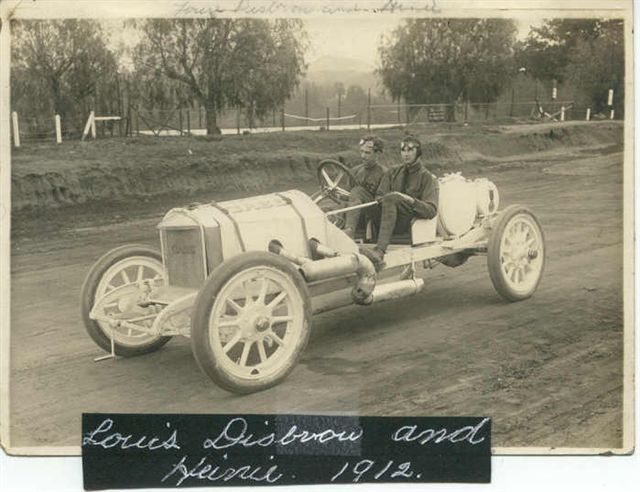
After WWI, the track was shortened to one-half mile, and races (most Indy-type “big cars” and motorcycles), continued until WWII.
During the suspension of racing for the war, fairgrounds director and majority owner Charles Somma died, and the fair was bought by a group (including my grandfather) who wanted to emphasize livestock sales, not fairs. At one point, the fair almost moved to Staunton, Va. Fortunately, the new group, dubbed the Atlantic Rural Exposition, decided fairs and livestock shows could co-exist.
But the big thing that happened was the fair moved. Somma had apparently been planning this already, because he had bought a farm property called Strawberry Hill, and the new owners built their new facility there, including a half-mile track (they wanted a mile but couldn’t fit it into their plans) for horse racing – they thought Virginia would legalize pari-mutual betting.
Like their predecessors 40 years earlier, though, they let the cars run, too, and during the 1946 Virginia State Fair, Ted Horn won a big car race that inaugurated auto racing at the new facility on October 12.
(Here comes the first “under the asphalt” history.) That was NOT, however, the first race in Richmond after the war. Midget racing had a successful two-month run at Richmond/City Stadium, and on Labor Day, the American Legion brought in a young (and pre-NASCAR) Bill France to put on a stock car race at the old fairgrounds track. Buddy Shuman won that event.
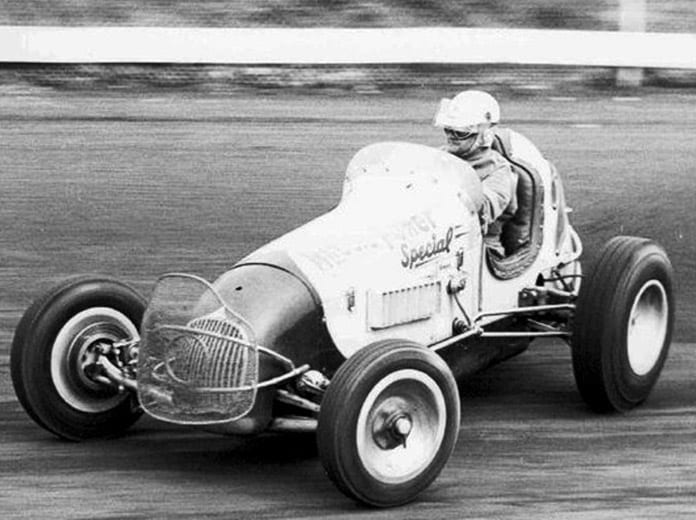
While everybody knows that Ted Horn won the first race at Richmond’s Strawberry Hill fairgrounds track, they may not know that the second race at the new track was run a few weeks later and won by Pennsylvania’s “Flying Farmer,” Tommy Hinnershitz, shown here at Reading nearly a decade later. Photo is from an article in Speed Sport.
Of course, since that time the fairgrounds has moved again, following Paul Sawyer’s purchase of the property from the Atlantic Rural Exposition folks, and International Speedway Corporation (now part of NASCAR) bought the whole enterprise from Sawyer, but the race track – although completely rebuilt in 1988 – still sits more-or-less where it did in 1946.
The track put together a “75 Greatest Races” list for its anniversary two years ago (I helped in a very minor way), and I’d recommend you look at that for a good summary of the higher visibility events. What follows could be considered lower visibility.
Here are some things you should know (well, maybe):
The original promoter was Sam Nunis. Before the war, Ralph Hankinson had promoted the fair races (another big car race on Labor Day was promoted by the local labor union trades council), but he also died during the war, and Nunis, one of his lieutenants, jumped in to assume his enterprises. He would continue to promote the State Fair big car (later sprint car) races until 1962.
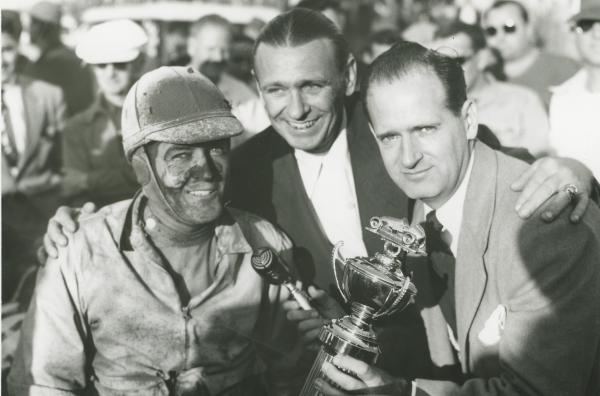
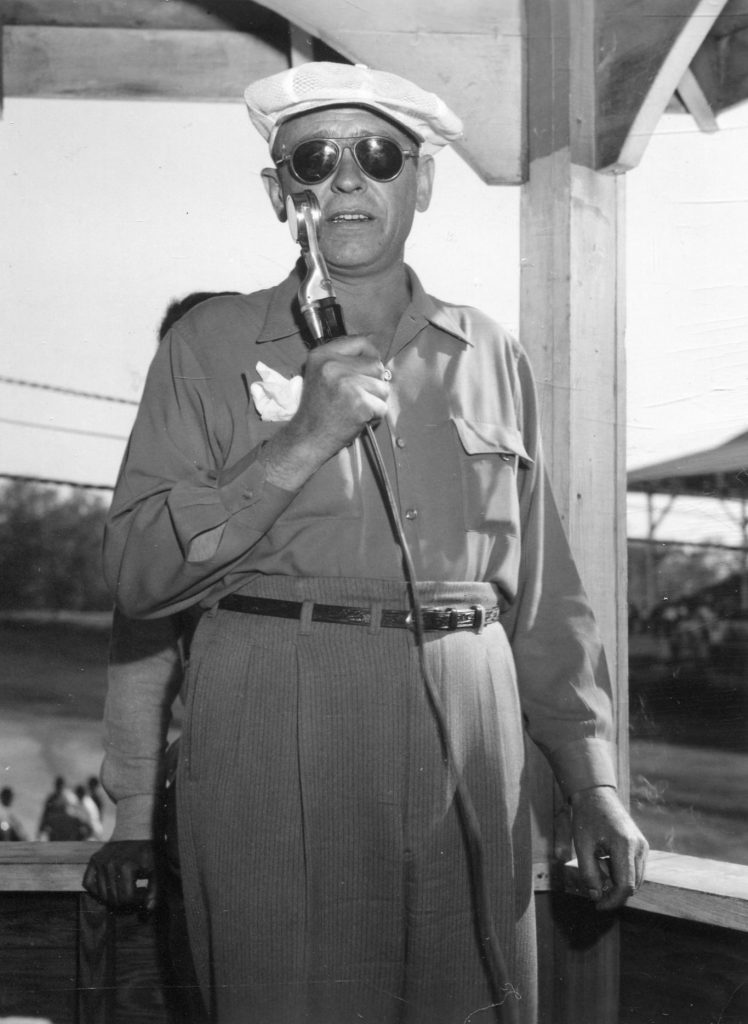
1948 was a big year. Racing at City Stadium had been shut down due to neighbor complaints, and rival promoters were trying to keep it going elsewhere. One of them, Sherman “Red” Crise, signed on at the fairgrounds to run the midgets there, and to accommodate him, the fair board installed lighting, and the first night race was run May 19. Unfortunately, Crise had a falling out with the fair board and was fired less than a month later, and before that situation could be stabilized, promoter Bob Streeter and Richmonder Nelson Royall opened their new midget racing track off Hull Street Road in South Richmond. Eventually, it would become Southside Speedway.
(For many years, the then-RIR public relations and marketing folks asserted incorrectly that the installation of Musco lights at the new track was the first time permanent lighting had been used. My buddy Dave Fulton led the eventually successful effort to convince them that their history was off by nearly half a century.)
Before his departure, Crise floated the idea of building a second track at the fairgrounds, just for midgets. The Henrico Supervisors even held a meeting about it. How’s that for what-might-have-been?
Initially, the track really didn’t have a name. It was just called the race track at the “new” state fairgrounds, or at the Atlantic Rural Exposition. Many Richmonders just called it Strawberry Hill. When Crise attempted his weekly midget racing, he dubbed the track “Atlantic Speedway,” which might have caught on, but after he was fired, the name disappeared.


Oh, and the night after the first daytime midget race at the fairgrounds, May 2, Crise and winner William Randall were caught by police drag-racing on Chamberlayne Avenue as they headed back to their hotel.
Three days before the first night race, the first stock car race was run at the fairgrounds, won by Red Byron. While NASCAR and the raceway trumpet this race today as NASCAR’s first, the sanctioning body was so obscure then that the Richmond Times-Dispatch doesn’t mention it at all and in fact identified Bill France with the National Stock Car Racing Association, his pre-NASCAR affiliation.
Later that year, a group called the Owner Drivers Association of Virginia began promoting stock car races at the fairgrounds and held three. Unfortunately, the final race – during the fair – was the scene of the track’s first fatality.
A well-known Richmond garage owner named Red McGinnis was in the pits when an accident took place on the track. He stepped out onto the surface to see what was happening and was struck by a spinning car. Later that fall, the first stock car race ever held at Royall/Southside Speedway was run in his memory.
In 1949, Nunis attempted to start weekly stock car racing at the fairgrounds, but when a small crowd turned out for the opener and drivers discovered that neither Nunis nor enough money to pay them was on hand, they commandeered the PA system to tell fans that the racing has been cancelled, and they should go home.
With weekly midget and stock car racing both having gone down in flames, no further weekly racing was attempted at the fairgrounds track.

Another spectator fatality took place in 1950, this time when a tire flew off a race car and went into the stands, killing one fan and injuring another. The survivor sued and eventually won.
Weekly racing made an unofficial, brief comeback in 1951, when – for a time – Nelson Royall promoted stock car races at Royall Speedway on Friday nights and at the fairgrounds on Sunday afternoons. Racing’s popularity was running pretty high at this point, and some enterprising entrepreneurs/fans opened a second weekly short track, Richmond Speedway, located where I-295 crosses U.S. 301 north of the city. Still, fans seemed to come out to fairgrounds events.
The next year brought the first “big-time” stock car race to the fairgrounds, but it was not a NASCAR-sanctioned event; rather, it was a AAA (later USAC) race, won by Jack McGrath.
1953 was a kind of “changing of the guard” year. The last AAA big car race was run at the fairgrounds; the next year that body would be replaced by the United Racing Club (URC), which would continue to sanction the events. Also, the AAA stock car race was not repeated but rather replaced by one sanctioned by NASCAR and promoted by Bill Rose (initially Nelson Royall’s right-hand man) and Joe Weatherly. Weather made it less than successful, and there was no follow-up event in 1954, but NASCAR would be back.



Most fans know that Lee Petty won the first Grand National/Cup race in Richmond in 1953, but they may not know the circumstances as explained in this story, or that less-well-known Richmonder Al Kent finished 14th, driving a Henry J.
By the way, while this was the first Grand National/Cup race at the fairgrounds, you can debate whether it was the first for the city. In 1951, ’52, and ’53, Royall had brought the Grand National Short Track Division to his track. That division ran the same cars but on tracks smaller than one-half mile. Same thing? You decide.
Instead of NASCAR, the fairgrounds hosted “new model” stock cars from the Circuit of Champions in 1954. NASCAR would later acquire this group and start its own Convertible Division from a similar class the C-of-C had been running.
That also was the year Richmond somehow wound up with THREE weekly short tracks, after Mooers Field, home to the Richmond Colts baseball team (who were forced to leave town when Richmond brought in the Virginians and built Parker Field for them on the site of the “old” fairgrounds racetrack), was leased to Nelson Royall, who built a racetrack there. This created an obviously unsustainable situation, but races continued at the fairgrounds, anyway.
At this point we bring in one of Richmond’s favorite racing characters, Joe Weatherly. The colorful former motorcycle champion and still very popular racer also was promoting, although he seemed to seldom stay at a given track for long. He had promoted several tracks in Tidewater, including one that was named Joe Weatherly Speedway for a while. Then he came to Richmond, briefly promoted Richmond Speedway, then shifted to both Royall Speedwat and the fairgrounds.
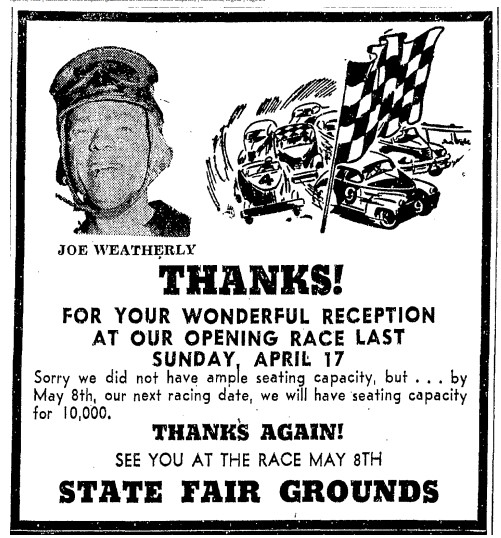
In time, he was joined at the latter post by Paul Sawyer. Together, they promoted the 1955 NASCAR Grand National race there, and while Weatherly (again) had soon moved on, for Sawyer it was the start of a string of more than 40 years of successful promotions at Strawberry Hill.
We’re kind of coming out of the dark ages now. The battle for weekly track supremacy was ending – by the end of 1955, only Mooers Field (a/k/a Speedrome or Speed Bowl) was still running, and that would be the status quo until Eddie Mooers sold the property for development in late 1958. The prospect of no weekly racing ended when J.M. Wilkinson bought Royall Speedway (almost by accident) and reopened it as Southside Speedway in 1959.
Throughout that period, Paul Sawyer continued to promote Grand National and Convertible Division races, plus frequent events for NASCAR’s Modified Division and occasionally even a midget race.
In 1958, Convertible driver Gwyn Staley died when his car flipped during a Richmond race. To date he remains the only driver killed in a race at Strawberry Hill.
The early Grand National races were 200 laps/100 miles, and car counts were unpredictable. After the spring 1961 race only drew 12 cars, Sawyer upped the fall race to 250 laps and hiked the purse substantially. From that point on, Richmond’s races – at 250 or 300 laps – were the biggest on dirt for the GN circuit.
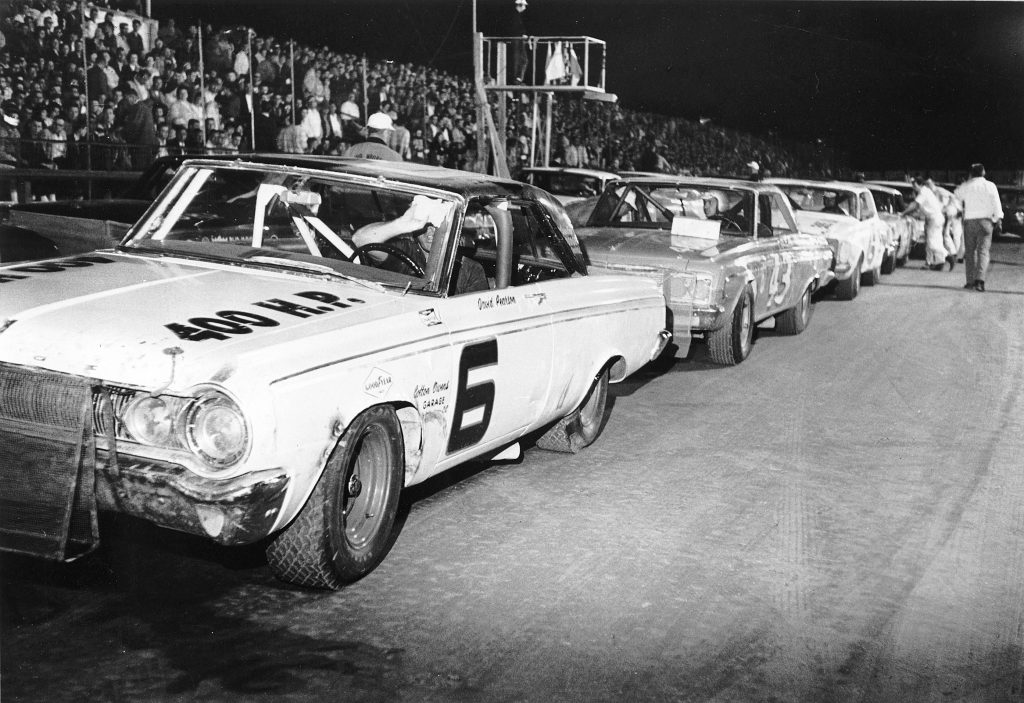
The 1962 Richmond 250 spring race was one of the oddest of ducks. Atlanta had been rained out a week before and Bill France wanted the make-up to be the Saturday before Richmond’s Sunday show. (Those tracks are more than 9 hours apart with today’s Interstate Highway System; think of how long the drive was 62 years ago.) To keep Paul Sawyer (and some car owners and drivers) from coming after him with a gun, he arranged for auto transport trailers to bring all the cars from Atlanta to Richmond. Most crews just had to drive all night.
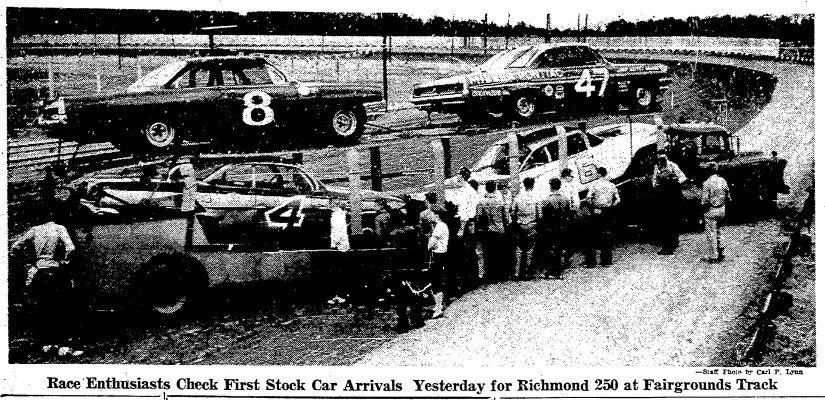
Atlanta was rained out again Saturday, so the schedule wasn’t quite so tight, and it all worked out, although the track was in horrible shape, and Rex White’s winning speed of 51.363 mph was the second slowest in track history, surpassed only by the rain-marred 1953 race.
From this point on, you probably know everything I could tell you: Sawyer saw the writing on the wall for dirt tracks and paved Richmond in 1968, then 20 years later saw the end coming for his decrepit old fairgrounds track and built Richmond International Raceway. Lights were added again, the fair moved, the track was sold, grandstands were added, then subtracted, a major “reimagining” renovation took place, and here we are.
You can’t walk around the speedway after a race anymore and look for souvenirs buried in the clay, but it’s still a helluva place to watch a race – and you don’t have to send any light-colored clothes you mistakenly wore to the cleaners.
I haven’t been there since I stopped working on race weekends 10 years ago, but it’s still home, and I might see if somebody can sneak in and leave my ashes there when I’m gone.
Hope this weekend’s race is awesome.
(The newspaper clippings used in this story are from the Richmond Times-Dispatch and were copied from the microfilm copies of the paper at the State Library of Virginia in Richmond.)
Frank Buhrman



Awesome, my dear pal, just an awesome read. Can’t believe it’s been 59 years since I first attended a Richmond race with you. The start of a wonderful run of great events at varied tracks. But Richmond’s Strawberry Hill was always home.
Awesome, awesome read, Frank. Can’t believe it’s now been 59 years since I started attending Richmond races with you – beginning of many racing adventures together. I just wish I’d been on board with you a year earlier when you started in 1963.
Thank you for taking the time to write this piece. Extremely informative and interesting. Kudos.
I WAS AT THE RACE WITH MY DAD IN 1948.
I WAS 13 YRS. OLD
WE SAT IN THE STANDS AND DURING THE RACE LEE WALLARD CAME THROUGH THE FENCE IN FRONT OT STANDS, HIT TELEPHONE POLE AND BROKE HIS LEG.
THE FOLLOWING YEAR LEE WON THE INDY 500.
THANKS FOR THIS WONDERFUL RACING HISTORY. NOW 89 YEARS OLD. GOD BLESS
James, I am so glad you wrote. Thank you. Tbe T-D had a photo of Wallard being pulled out of his car. I so wish there was some film of those early years. You, at least, have awesome memories.
Fantastic read, Frank. Thank you.
Aren’t memories wonderful?